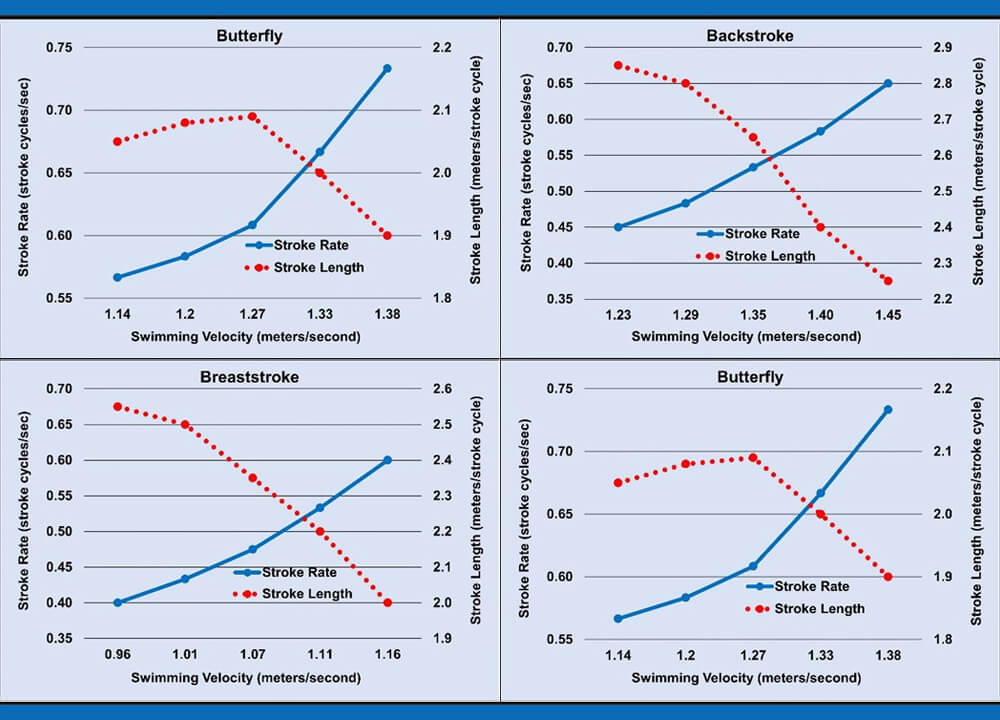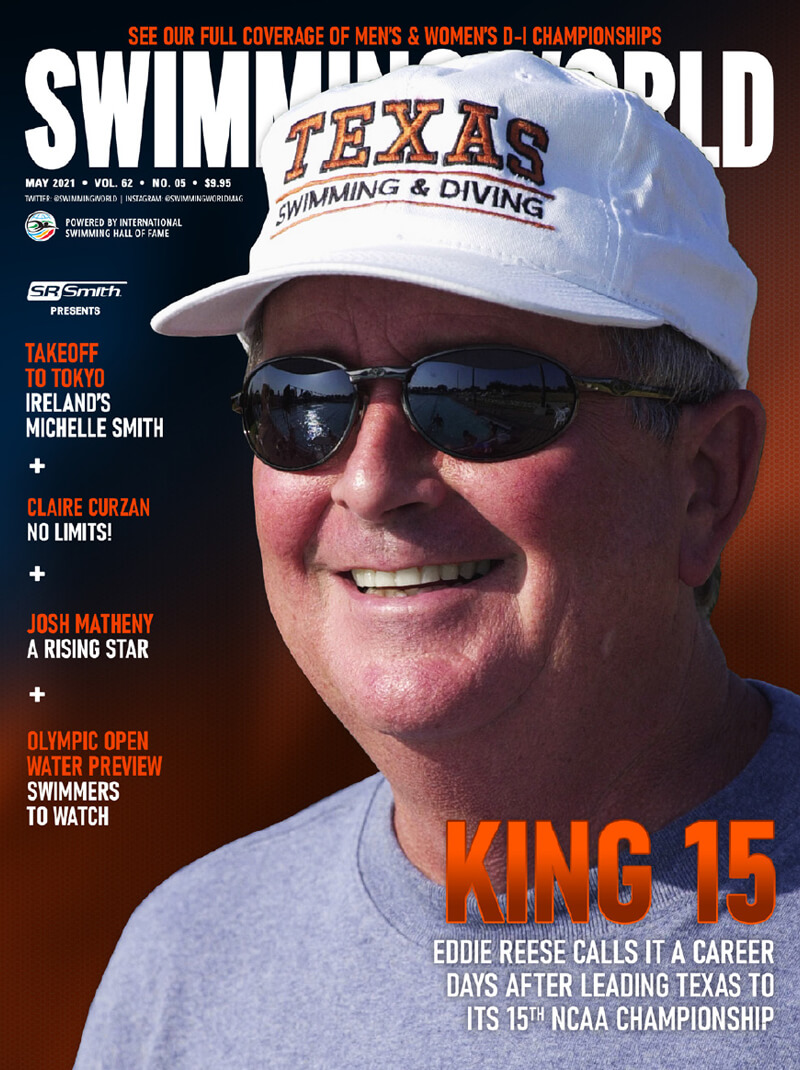Swimming World Presents – Swimming Technique Concepts: Maximizing Swimming Velocity Part 1- Stroke Rate vs. Stroke Length

The latest issue of Swimming World Magazine
is now available for download in the Swimming World Vault!
Non-Subscribers Can Download This Issue Here
Swimming Technique Concepts: Maximizing Swimming Velocity Part 1- Stroke Rate vs. Stroke Length
By Rod Havriluk
As explained in last month’s article (SW April 2021), using a scientific approach to improving technique has decided advantages over using a champion as a model. The article also explained that a scientific approach begins with developing a model for optimizing performance.
Swimming velocity is the criterion measure for swimming performance and is the product of stroke length and stroke rate. This article explains how stroke length and stroke rate vary and how stroke time provides insight into maximizing swimming velocity.
DETERMINISTIC MODEL FOR SWIMMING VELOCITY
Deterministic models for human performance were first presented by Hay (1983) to show the relationship of component variables. Exploring these relationships can help to identify key factors to improve performance. A deterministic model for swimming performance shows the relationship of stroke length and stroke rate with swimming velocity.
A swimmer can increase swimming velocity by increasing either stroke length or stroke rate. However, an increase in stroke length usually decreases stroke rate, and an increase in stroke rate usually decreases stroke length. The challenge to swimming as fast as possible is for a swimmer to maximize both stroke length and stroke rate.
CHANGES IN STROKE RATE AND STROKE LENGTH WITH SWIMMING VELOCITY
It is natural for a swimmer to increase stroke rate to increase swimming velocity because it is natural to move the arms faster to swim faster. For example, groups of male and female specialists increased stroke rate and swimming velocity over a series of 5 x 200 meter swims to a maximum effort on the fifth swim (Carvalho, Soares, Zacca, Sousa, Marinho, Silva & Fernandes, 2020). For each of the four strokes, while stroke rate increased, stroke length decreased (as shown in Fig. 2).
Stroke rate values increased by an average of 39% over all four strokes (butterfly 29%, backstroke 44%, breaststroke 50%, freestyle 33%). Stroke length values decreased by a more modest average of only 15% (butterfly 7%, backstroke 21%, breaststroke 22%, freestyle 11%). The data support the fact that swimmers increase stroke rate to swim faster.
Dr. Rod Havriluk is a sport scientist and consultant who specializes in swimming technique instruction and analysis. His newest ebooks in the “Approaching Perfect Swimming” series are “Optimal Stroke Technique” and “Swimming Without Pain,” and are available at swimmingtechnology.com. Contact Rod through info@swimmingtechnology.com. All scientific documentation relating to this article, including scientific principles, studies and research papers, can be provided upon demand.
To access the full Swimming Technique Concepts article complete with illustrative graphs,
Click here to download the full May 2021 issue of Swimming World Magazine, available now!
T
[PHOTO CREDIT: ISHOF ARCHIVE]
Get Swimming World Magazine and Swimming World Biweekly FREE When You
Become A Member of the International Swimming Hall of Fame
New! 30 Day Membership to ISHOF AND Digital Swimming World Subscription for just $10 a month!
Want more? Get a 1 Year ISHOF Family Membership With Swimming World Print AND Digital Subscription Order Now!
Non-Subscribers can click here to download this issue for only $5.94
Swimming World May 2021 Issue
FEATURES
014 WOMEN’S NCAAs: A NEW NO. 1
For the first time in the history of the NCAA Division I Women’s Swimming and Diving Championships—since 1982—the University of Virginia finished first. It was also the first time it cracked the top 5 with its previous highest finish sixth in 2019.
- VIRGINIA’S ROAD TO HISTORY
by Dan D’Addona - NC STATE ADDS TO ACC DOMINANCE
by Dan D’Addona - THE TALK OF THE MEET: MAGGIE MacNEIL
by John Lohn
018 MEN’S NCAAs: THE PERFECT RETIREMENT GIFT
Days before their coach, Eddie Reese, officially announced his retirement from coaching after 43 years, the Texas men’s team won their 15th men’s NCAA national team championship.
- THIS ONE’S FOR EDDIE!
by Andy Ross - SCINTILLATING PERFORMANCES: SHAINE CASAS & RYAN HOFFER
by John Lohn - PATIENCE REWARDED: MAX McHUGH & NICK ALBIERO
by Andy Ross
022 NCAA D-II CHAMPS: SOME THINGS NEVER SEEM TO CHANGE
by Andy Ross
A year into the pandemic that has completely changed our world, Queens University of Charlotte brought about some stability to the 2021 NCAA Division II Swimming and Diving Championships by sweeping their sixth straight women’s and men’s team titles.
023 NO LIMITS!
by David Rieder
Claire Curzan has been swimming fast since she was a young age grouper and has continued to do so in high school. Last March, she came within 13-hundredths of the American record in the short course 100 fly, and in April, she found herself within 22-hundredths of the long course U.S. best. She’s versatile, she’s coachable, she has international experience, and she’s moved from a fringe Olympic contender to an Olympic favorite. Curzan is only 16, and her promising future couldn’t be brighter.
026 TAKEOFF TO TOKYO: WHEN IRISH EYES WEREN’T SMILING
by John Lohn
Ireland’s Michelle Smith—a four-time Olympic medalist in 1996 who received a four-year ban from the sport in 1998 for tampering with a doping sample—has been defined as being a poster girl for cheating, and by her willingness to cut corners and take advantage of performance-enhancing drug use to make the leap from an athlete of very-good skill to one of elite status.
029 50 SWIMMERS, 6 MEDALS
by Dan D’Addona
The Tokyo Olympics will mark the fourth occasion that open water swimming will be contested on the Olympic level, and even a 10-kilometer marathon race can bring exciting moments and dramatic finishes.
030 JOSH MATHENY: RISING STAR
by Matthew De George
From a middle-schooler newly committed to swimming full-time in 2016, the future looks encouraging for 18-year-old Josh Matheny, who approaches the U.S. Olympic Trials for Tokyo in June as a dark horse to make the team in men’s breaststroke.
032 ISHOF: THE ART OF SWIMMING
by Bruce Wigo
This is the story of Hero and Leander, Lord Byron and the birth of open water swimming.
035 NUTRITION: HYDRATION—BEYOND THIRST!
by Dawn Weatherwax
Hydration truly has a daily importance for all kinds of swimmers from age groupers to Olympians to Masters swimmers, but it tends to get more notoriety when the weather gets warmer.
COACHING
012 THE POWER OF POSITIVE COACHING
by Michael J. Stott
Relationships built upon honesty, trust and communication go a long way toward cementing a bond between coach and athlete. Coupling that with knowledge of the individual first and athlete second produces a positive working relationship that can last for a lifetime.
038 SWIMMING TECHNIQUE CONCEPTS: MAXIMIZING SWIMMING VELOCITY (Part 1)—STROKE RATE vs. STROKE LENGTH
by Rod Havriluk
Swimming velocity is the criterion measure for swimming performance and is the product of stroke length and stroke rate. This article explains how stroke length and stroke rate vary and how stroke time provides insight into maximizing swimming velocity.
042 Q&A WITH COACH STEVE HAUFLER
by Michael J. Stott
044 HOW THEY TRAIN CHARLOTTE SHAMIA
by Michael J. Stott
TRAINING
037 DRYSIDE TRAINING: THE IM DRYLAND CIRCUIT
by J.R. Rosania
JUNIOR SWIMMER
047 UP & COMERS: TEAGAN O’DELL
by Shoshanna Rutemiller
COLUMNS
008 A VOICE FOR THE SPORT
011 DID YOU KNOW: ABOUT THE MOREHOUSE TIGER SHARKS?
046 THE OFFICIAL WORD
048 GUTTERTALK
Swimming World is now partnered with the International Swimming Hall of Fame. To find out more, visit us at ishof.org



